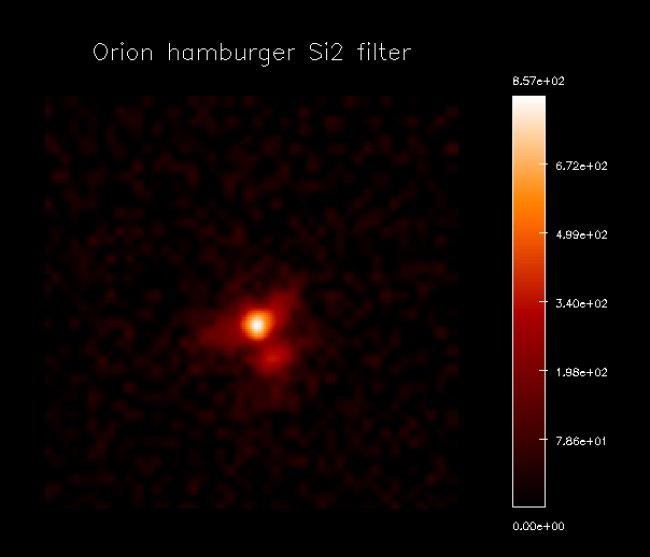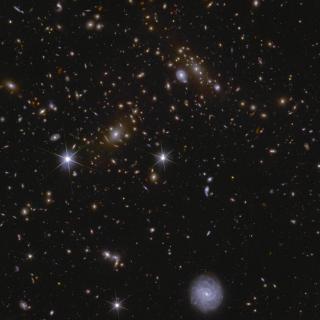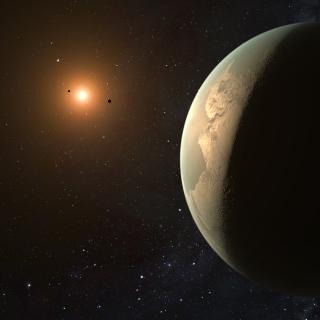The morning began with results from Canaricam. Christopher Wright, (UNSW Canberra University of New South Wales) studies very cold objects, stars in the early stages of formation, much younger than the Sun. These stars, which are surrounded by an envelope of gas and dust, emit thermal infrared radiation (similar to that emitted by human beings) but are not detectable in the optical. The CanariCam instrument on the GTC works in the thermal infrared, and can be used to study these and other types of cool objects which emit at similar temperatures. In addition, as Wright explained, CanariCam is the only instrument in the world which can also detect polarization, which allows it to take images of the magnetic fields around these very young stars. In these fields the dust particle are aligned along the field lines, which allows us to obtain extra information about star forming processes.
From stars the presentations turned to planets. Planets form from discs of dust found around stars. To know the composition of these discs, and particularly the size of their dust particles, is very important for the scientists, because this determines how they will stick together to form larger bodies. It is difficult to observe these objects in the visible, because the discs emit less than one billionth of the light of their star, and this masks them. Eric Pantin (University of Florida) who studies planet formation processes, introduced us to the Orion Nebula. There the astronomers have observed a disc sideways on. He compared it to a hamburger, in which we can see the bread but not the meat (in the centre). It is also slightly tilted, so that the upper part is easier to see than the lower. From the images obtained the size of the particles on the surface of the disc could be inferred: 10 microns, a thousand times bigger than the particles in the interstellar medium. These large particle would be expected to sink into the centre (to the “meat”) so there must be “turbulence” which makes them float to the surface. These results imply that the process of aggregation of particles which will give rise to a planet has begun. The study was carried out with CanariCam, which allows us to observe these discs at high resolution, and which observes at 10 microns (middle infrared). They could not be seen in the visible, which gives a better response for particles smaller than 0.1 to 0.5 microns. In the world there are only two instruments of this type, CanariCam on the GTC and VISIR on the VLT (Very Large Telescope).
And from planets to galaxies. Astronomers think that when they are in groups their evolution depends on the density of the medium in which they are found; this determines whether they form more stars or less, earlier or later…Galaxies also come in different shapes. The evolution of the universe from its inception is a process of hierarchical assembly, as if it were a 3D jigsaw. Miguel Sánchez-Portal (European Space Astronomy Centre, ESAC/ESA ISDEFE) studies the evolution of galaxies in clusters, whose properties change with cosmic time, or so it is thought. Put another way, the characteristics of a group of galaxies in a distant cluster (closer in time to the origin of the universe) are different from one much nearer, which is more structured. It is of interest to know how this occurred, and one way is to understand better the formation of the stars in the galaxies, which are studied using emission lines. As they are faint and distant the study requires a very large telescope with much light-gathering power. For this reason in the GLACE project the GTC plus OSIRIS are used, which Sánchez-Portal defined as “a machine for observing star-forming galaxies”. They have used 120 hours of observing time on the GTC to observe emission lines in clusters at different distances, and the field of 8 arcminutes gives very good coverage. The objective is to see how galaxies change inside each cluster depending on local densities and time.
And to finish this small selection from the twenty or so presentations made on the second day, we will talk about a project, which began as an ESO-GTC Large Programme (210 hours of observation) and has recently been renewed as a GTC Large Programme (240 more hours of observation). Why do they need so much time on a telescope of over 10 metres in diameter? Pablo Pérez-González (Universidad Complutense de Madrid, UCM) explained that the SHARDS project studies different scientific fields. The main idea is to get to know about the evolution of galaxies, which we do by detecting an analyzing the furtherst galaxies possible to observe, down to the nearest. SHARDS takes photometric images with OSIRIS in the optical range, using medium bandwidth filters which exist only on this instrument.
These filters “see” the most distant objects and with the greatest possible detail, which allows us to distinguish the structural components of a galaxy, to distinguish between young and old stars, to measure the amount of dust present, to distinguish the phase of the gas, whether ionized or not, etc. Among its results SHARDS has found “dead” galaxies (with no star formation) more massive than the Milky Way which existed when the universe was really young, and could determine that those galaxies formed very quickly (in 200-400 million years) which does not agree with the predictions form theoretical models, which claim that the most massive galaxies are formed by the coagulation of smaller ones. How can a galaxy bigger than the Milky Way be formed in a time shorter than that taken to form the Solar System (4,500 million years)? They will have some hours of GTC time to answer that question.
After two days devoted to astrophysics, on third day it will be the turn of technology. None of the science discussed until now would have been possible without it.
The V International Conference "Science with the GTC" is organized by the Instituto Nacional de Astrofísica, Óptica y Electrónica de México (INAOE) and the Instituto de Astronomía of the Universidad Nacional Autónoma de México (IA-UNAM), with participation by the Instituto de Astrofísica de Canarias (IAC) and the University of Florida (UF).
The GTC is the result of an international collaboration between Spain (IAC), Mexico (IA-UNAM and INAOE) and the United States (UF).
Annia Domènech
More information
Website of the V International Conference “Science with GTC”
The 5th International Conference on “Science with the GTC” starts tomorrow
Press contact
Annia Domènech
annia [at] iac.es (annia[at]iac[dot]es)



